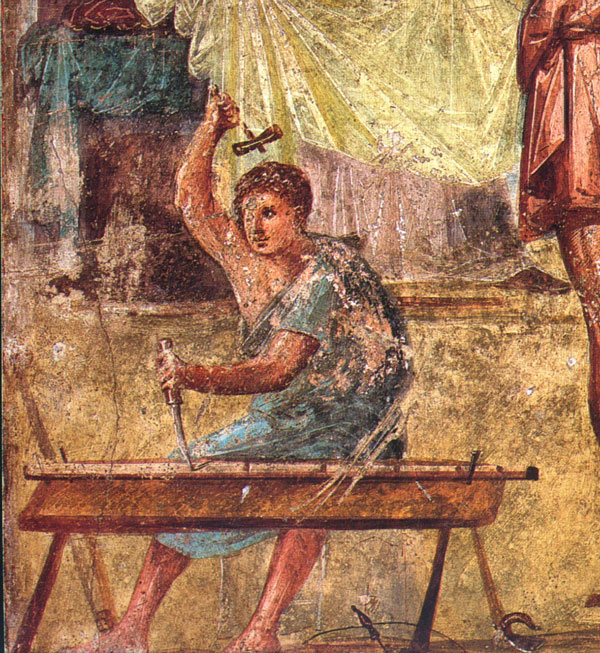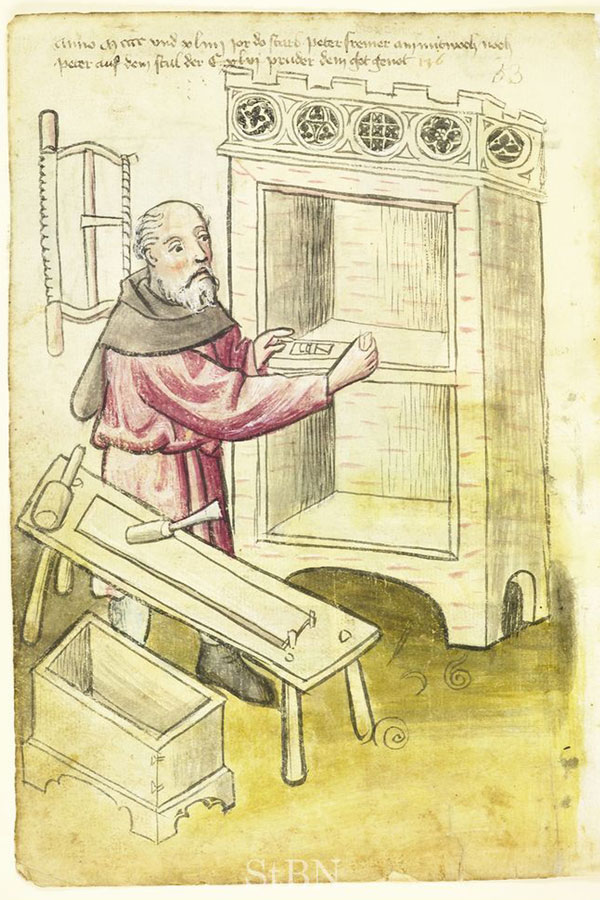We may receive a commission when you use our affiliate links. However, this does not impact our recommendations.
The first time I saw an 18th-century workbench, I thought: Wow. That will never work.
But then I built some of these benches (dozens, actually), and I am a huge fan of the form’s stability, simplicity and purity.
So the first time I saw a Roman workbench from 50 A.D., I thought: Hmmm. That would never work. But then, in a rare act of self-awareness, I caught myself before I dismissed the form entirely.
Roman workbenches are almost certainly not the first workbenches in our culture. The Egyptians had rocks with notches that they would use for bracing the work, which probably counts as a proto-bench. But the Roman form is undeniably dominant in art from the time of Pompeii up until the 15th or 16th centuries.
Let’s put that in perspective. The so-called “European” workbench has been around for about 200 years. The Roman bench was popular for more than 1,400 years.
So it probably has some merit.
But when I look at the thing, I can’t help but think that it’s spindly, lightweight and springy. It looks too low – many times artisans are pictured sitting while working at the bench. And there is very little in the way of workholding devices – perhaps some nails or pegs that you can push your work against.
There is little doubt that the Roman bench is solidly made. From drawings of the bench we can discern that it is made with a solid plank top that has legs tenoned into it. This is the same format for one of the most durable forms of furniture ever: the Windsor chair.
There is no shelf below the top. No stretchers to join the legs. So all the strength of the workbench comes from the top. This, as you might know, is the same place the old French benches get their strength.
But to my modern eye, the top looks too thin. The legs look like pipe cleaners. I can’t imagine working on a bench that is about knee-high.
But this week I am in Venice, Italy, with my family. Yeah, it’s totally clogged with tourists. It’s crazy expensive. And the smell can be quite ripe. But there is little doubt that this city, its houses and its furniture were built with the help of Roman workbenches. (And if you don’t believe that Roman woodworking was sophisticated, you need to read Robert Ulrich’s book “Roman Woodworking,” which is filled with some very sophisticated joinery.
I have recently become convinced that I need to build some of these Roman benches and try them out. This could be a total dead end. Or I might learn something. Either way, I get to do some woodworking in a toga.
— Christopher Schwarz
Here are some supplies and tools we find essential in our everyday work around the shop. We may receive a commission from sales referred by our links; however, we have carefully selected these products for their usefulness and quality.











At least the Estonian benches appear to be made from the outer slabs from the tree as it was split or sawn with curved outer surface stripped of bark and drilled for the legs. That would very likely simplify getting the legs splayed properly for stability. The bench in the Pompeiian fresco also looks that way too, though the detail is weak. The two Medieval German benches are not.
Venice, wow! Love that place! I have not had the misfortune to be there during the hot/smelly months. I realize you’re long gone from there by now (telling me I need to read your blog more often). I hope you got a chance to check out Livio De Marchi’s shop and studio while there.
It always amazes me that they could build ANYTHING that was worth a darn, when they could NOT draw a simple isometric diagram of the project. Shouldn’t all the furniture be skewed and obtuse or something?
Dave
What is up with the guy in the picture holding his mallet high enough to drive a railroad spike?
In all three images, the legs are tapered, much wider at the bottom. Still, to do the planing shown in the last image, the bench would need to be rock solid and steady. I just can’t see those legs managing it.
I’m intrigued by the box next to the bench, though . . .
Speaking of old Roman style benches, does anyone know what a Jew from Nazareth might have used as a carpenter? Of course I’m speaking of Jesus Christ, who was known as a carpenter.
I am currently building a workbench that has taken 2 yrs to research, I find it interesting to see the simple Roman bench. De Vince had it right the “Simplicity is the ultimate sophistication.”
Chris you have to quit putting those scary images of you in a toga in you writings. That is just too much for my mind to picture.
There is a plank floating around a museum that is supposed to be the top of a Roman carpenter’s bench – 4 broken off legs and several angled notches in the edges as well as what we would call ‘dog holes’ IIRC. Can’t remember exactly where it is referenced either.
One thing I’ve learned in the study of technological history is that our ancestors used with muscle power controlled by skills developed over tens of thousands of hours of training as a means of performing task we build special purpose technology fore. They would routinely perform physical acts that we would put in a circus if we saw them today.
A good example would be the working of sails in great ships in the age of sail. Going a 100+ feet in the air to move around really heavy sails while having nothing but a rope to stand on would be a circus trick today but generations of sailors did it every day in all kinds of weather with very few accidents. They used a knowledge of hundreds or even thousands of types of knots to perform a wide array of task we wouldn’t even associate with rope at all. The technology of the rope was simple, the skill of knot tying vast and expensively learned.
It probable that the Roman workbench evolved in parallel with a system of training woodworkers from the age of 7 such that the woodworkers body and skill were as much a part of the operation of the bench as the wood and joints. The actual way the bench was used is lost to time.
In Bardstown KY, there’s a complex of small museums with an interpretive area – several log buildings along a creek. One of those buildings has a very similar bench that has a wood screw end vise incorporated into it.
It’s been eighth on my ‘to be built’ list for some time. Perhaps it’s time to order the wood screw and get it built.
I’ve always just assumed that the Roman style bench was set against a post or wall to resist movement of the bench when planing.
If so, I can understand why artists chose not show benches in this position because it could make an awkward image – and besides artists at the time were having difficulty with perspective. But on the other hand, you would expect at least a few artists to attempt to show it this way if this was how benches were actually used.
Steve
A while back I watched a travel program about Venice. There is a section of town were the gondolas are built. They showed a shop were parts for the boats were being made. The workers were using large free standing leg vices to hold the work pieces. They were doing rough shaping with draw knives. The leg vices allowed them to attack the work from all sides. Kinda cool.
Might be something interesting to check out during your stay. Enjoy your vacation.
I believe Jenny Alexander has worked at a bench very similar to these for years. Seems to work for her. I believe she used it mostly for boring and mortising. This design has some distinct advantages, especially when paired with a shaving horse. I realize these monks are using planes instead of shaves, but you won’t find any high benches in a traditional Japanese workshop either. There is something to be said for not having to stand all the time. And your weight can be a great stabilizer for the bench.
I wonder how much accurate detail we can discern from these pictorial representations. Clearly they were meant to convey the general idea of the woodworker and his world, but not so sure that the artist intended to give proportion, thickness, and other details with much accuracy.
The two drawings are wonderful and appear to be medieval clerics or monks at work. The box on dovetailed frame is sweet. What is the provenance of these drawings?
As an aside…….I’m reading a book on the history of time, and it’s unbelievable how brilliant some of the medieval monks were. Richard of Wallingford, Abbot of St. Alban’s in the 1200’s pretty much developed a clock, including metal gears, calculating the proper wheel diameters, ratios, etc., etc. He made all the parts himself!
Well as for tradition in workbenches one should have a look at japanese / chinese style benches. Without holdfasts, work done sitting.
http://www.youtube.com/watch?v=hwzeONtOAFg&list=PL2X-IN_a8zCjo0rjxBOIvnxHS4T6X46Ax
Don’t understand a word but looks impressing.
Im intrigued by the plank with a hook on the floor before him. It also may have a bradawl stuck in it.
Best
John
The low height and the representation of workers sitting at them (or on them) must be the reason why we call them workbenches instead of work tables. The Italian word “banco” is where we get the English word bank from. Money changers in the late Middle Ages and Renaissance would sit on their benches in open market areas and count out money for exchange. They became so wealthy they were able to move indoors and start loaning at interest.
Sitting on the work while you work on it can have advantages; easier on the feet, perhaps make mortising a tad easier, etc. I read Ulrich’s book a few years ago. If I remember correctly, he says Roman planes were set at a higher angle (63 degrees, I think, as opposed to our modern day 45). The higher angle may have been more difficult to move over the wood and perhaps the lower bench height would enable you to to put more of your body weight above and behind the plane as you push it, but that is just a wild, wild guess on my part with nothing to support it.
Look forward to reading more on this subject.
“many times artisans are pictured sitting while working at the bench” . . . perhaps the user employed his thighs as the foundation of the bench top and the bench legs simply provided convenient access to get ones human legs under the bench.
I would not recommend woodworking in a toga. They were made of wool, and were quite voluminous–not to mention, when worn correctly, they would be draped over your arm. So, hot, uncomfortable, and in the way. A linen tunic would be much more conducive to work, and probably more historically appropriate, plus it will let your nether regions breathe quite a bit more easily. And it would have been worn under the toga anyway, so just lose the top layer.
Maybe the bench works best in a world lacking three-point perspective; secrets lost to our modern times.